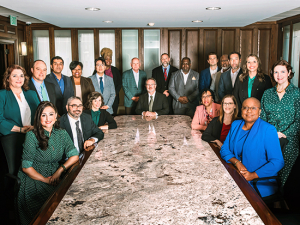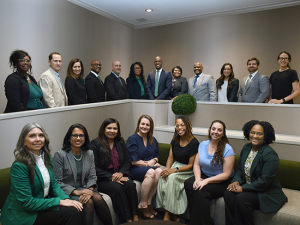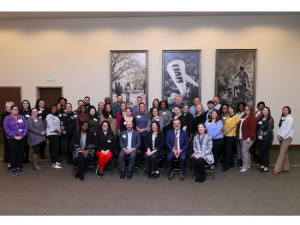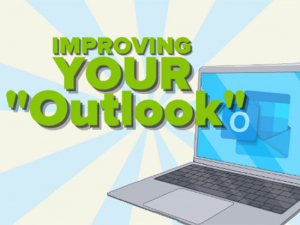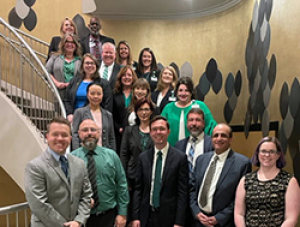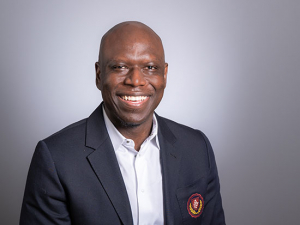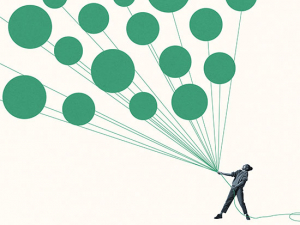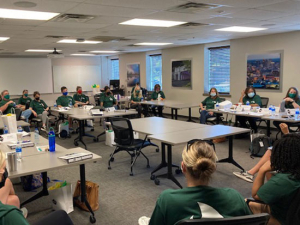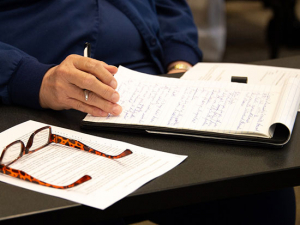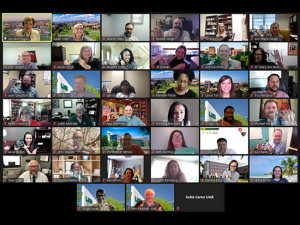 Kecia Thomas, Ph.D., and C. Allen Gorman, Ph.D., bring decades of research experience as industrial-organizational psychologists to their leadership roles as dean of the College of Arts and Sciences and chair of the Collat School of Business Department of Management, Information Systems and Quantitative Methods, respectively. How do they apply their understanding of workplace behavior in their own workplaces?One of the primary goals of a leader at any level is to shape the organizational culture — the system of shared assumptions, values and beliefs that define appropriate and inappropriate behavior in a workplace.
Kecia Thomas, Ph.D., and C. Allen Gorman, Ph.D., bring decades of research experience as industrial-organizational psychologists to their leadership roles as dean of the College of Arts and Sciences and chair of the Collat School of Business Department of Management, Information Systems and Quantitative Methods, respectively. How do they apply their understanding of workplace behavior in their own workplaces?One of the primary goals of a leader at any level is to shape the organizational culture — the system of shared assumptions, values and beliefs that define appropriate and inappropriate behavior in a workplace.
UAB’s culture is defined by its vision, mission and shared values, which “provide a framework and common language for collaboration and strategic goals,” in the words of Forging the Future, the university’s strategic plan.
It is the responsibility of leaders to help their teams understand how this framework applies to the day-to-day work of a unit, school, department or office. To focus on the shared values, how do the institutional commitments to diversity and inclusiveness, for example, or collaboration affect operations?
“In every organization, there is a formal system and an informal system,” said Kecia Thomas, Ph.D., dean of the College of Arts and Sciences. Thomas has three decades of experience in the scientific study of human behavior in organizations as a professor of industrial-organizational psychology — usually referred to as I/O psychology. Her research has specifically focused on why diversity initiatives succeed and fail in organizations. (The second edition of Diversity Resistance in Organizations was published in 2020.)
The formal system is the one reflected in the institution’s websites, handbooks and manuals, Thomas explains. The informal system, on the other hand, “reflects how things really get done,” she said. But the two do not need to be opposites, Thomas adds.
Leaders have the power, and duty, to minimize the difference between how things should get done, and how they do get done, in their teams. Thomas and another UAB specialist in I/O psychology, C. Allen Gorman, Ph.D. — the new chair of the Department of Management, Information Systems and Quantitative Methods in the Collat School of Business — share five ways to make that happen, based on their research and their own leadership experience.
1. Clearly define your culture
“The first thing I did on day one was say, ‘This is who I am, what I value and what I would like us to value in this department,’” Gorman said. “I talked about the school’s vision and the university’s vision and how I saw that we could fit in with that and add value to that. It is important to make that culture and where we want to go very transparent.”
“If you wait once a year to give an appraisal, you are unlikely to see an impact on day-to-day behavior. You must have a culture that encourages and embraces feedback throughout the year.”
In her dean’s message, and as she talks with her chairs, faculty, staff and students, Thomas explains that the goals of the College of Arts and Sciences — including retention and graduation of students who are career-ready, community engagement, and research and scholarship — depend on an overarching goal: “to become a model of Inclusive Excellence.”
“We cannot truly be excellent without recruiting, retaining and developing diverse talent,” Thomas writes. After explaining the benefits of diversity across the school in terms of more transparent communication, avoiding group-think and better problem-solving, Thomas elaborates on what a culture of Inclusive Excellence means in practice. “Each member of the College of Arts and Sciences understands that they have an opportunity for voice, a sense of value and of belonging, as well as feelings of investment and ownership in our collaborative mission to serve the educational needs of our community,” she writes.
2. Use feedback to translate culture into practice
In the College of Arts and Sciences, Thomas has organized her evaluations of the school’s 19 department chairs around UAB’s strategic plan and made clear that creating a diverse and inclusive environment in their departments is “on the list” of priorities, she said. “No one was evaluated on this for 2020 — it was just setting the expectation,” Thomas said. “Next year, that will be part of the formal process.”
UAB implemented a campus-wide, standardized system of performance management in 2020 as a response to faculty and staff feedback on the 2017 Campus Engagement Survey. (This year’s performance evaluation period closes Sept. 30.) Performance management emphasizes the importance of setting performance expectations for all employees and supporting individual growth and development during regular check-ins throughout the year.
“Feedback is always there. It shows up in how people get rewarded and recognized or even avoided.... As leaders, we have to have the courage to disrupt this.”
“If you wait once a year to give an appraisal, you are unlikely to see an impact on day-to-day behavior,” said Gorman, whose research has focused on performance management techniques and who consults with organizations seeking to implement more effective performance management processes. “You must have a culture that encourages and embraces feedback throughout the year.”
“And it is important to recognize that feedback is always there,” Thomas said. “It shows up in how people get rewarded and recognized or even avoided. Let’s go to the worst-case scenario: An employee engages in intimidation and bullying, and everyone knows it. If they never get confronted and given a timeline to change their behavior, that’s a form of feedback. As leaders, we have to have the courage to disrupt this. The important piece is to normalize putting these feedback loops into place so that they are expected and everyone knows they are going to be held accountable.”
3. Priorities and goals may differ, but leaders help identify common ground
Gorman is chair of a large department that is home to several disciplines. “The information systems folks are very different from the human resource management people,” he said. “They have different priorities and goals for their work. But underneath, there are commonalities that bring us together. We care about our students and want to see them succeed and get jobs, for example.”
“Our faculty and staff, like our students, are whole people — they are not just their experience and their training. They want to know that you are authentic, and that means having a bit of vulnerability.”
Setting aside time to meet and discuss these commonalities can be very helpful, Gorman says. “Next semester, we are going to go off-campus and do a strategic retreat, COVID-permitting,” he said. “We will talk about what we have in common, who we are and our shared goals.”
One of Thomas’ methods of enhancing community is to survey her 19 department chairs frequently using short online forms. “I’ll ask them for feedback on a topic or ask what they are thinking about,” Thomas said. “That is easy and quick and much simpler than trying to convene a meeting. And I make sure to share that collective feedback when I present the research priorities of the college or plans to move forward in various areas.”
4. Be willing to experiment — and revert
As researchers trained in the field of organizational development, both Thomas and Gorman recognize that change can always be threatening.
“Whenever I present an opportunity or a change in how things were done in the past, I say, ‘Let’s try it. I think we have enough evidence to do that,’” Thomas said. “‘And we’ll circle back in a year to see whether we need to fine-tune it or abandon that change.’ Our mindset needs to be that we are a learning organization that is always moving forward and having the goal of becoming more successful, but that we are not afraid to revert back to where we were.”
“Our mindset needs to be that we are a learning organization that is always moving forward and having the goal of becoming more successful, but that we are not afraid to revert back to where we were.”
“There’s an expectation that, if we create a new program or initiative, it has to exist in perpetuity,” Gorman said. “No, it doesn’t. That might be a holdover from the classic academic model, but we can borrow what other organizations and businesses do. They are always guessing and testing and seeing what works. We can allow ourselves the freedom to do those things and create a culture where it is safe to experiment.”
5. People respond to people, not programs
A background in I/O psychology certainly helps in the real-world tests of leadership. “It becomes a part of who you are,” Thomas said. “I can’t divorce myself from 28 years in the field and five years of grad school before that. My work with the STEM community, for example, has really helped me understand my STEM departments here, and hopefully serve them better.”
“It seems like a natural advantage” to have an I/O psychology background, Gorman agreed. “You understand the life processes involved and understand people and relationships and the value of those relationships. You realize that you can’t do anything on your own.”
“Our faculty and staff, like our students, are whole people — they are not just their experience and their training,” Thomas said. “They want to know that you are authentic, and that means having a bit of vulnerability.”
During meetings, “it is not uncommon for me to share a challenge I might be facing professionally or personally,” Thomas said. “Recently I left Nashville at 5:30 a.m. from dropping my senior off at college and just made it back in time for my staff meeting, so there was tiredness and emotion there. Leaders who are willing to share a bit of themselves give their followers the permission to seek what they need to be effective, too.”
Training and resources
Managers and leaders at UAB can find courses, programs, tools and resources from Organizational Learning & Development at uab.edu/humanresources/home/learndev.



